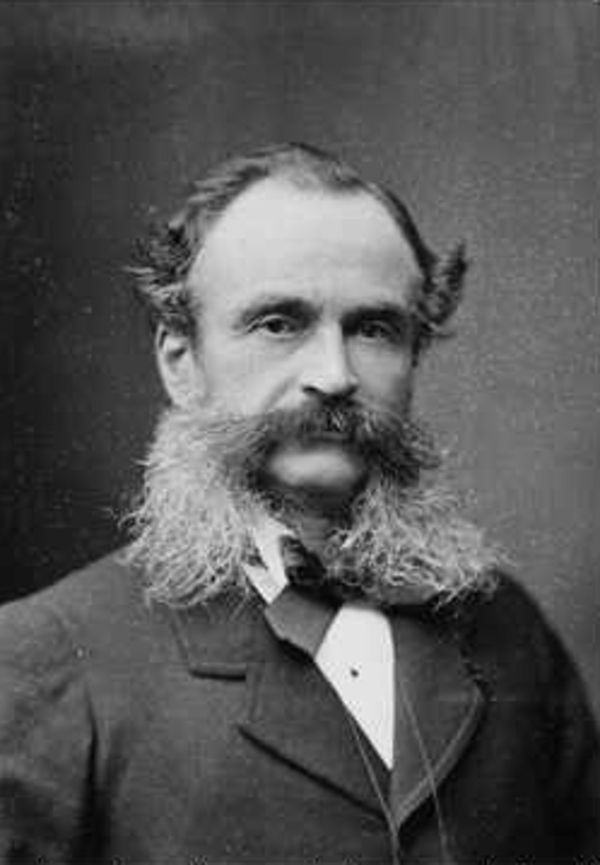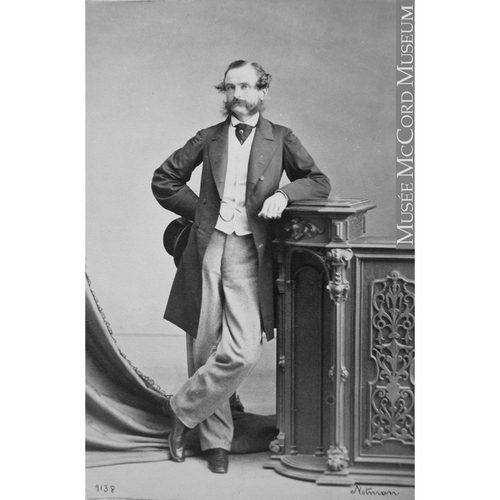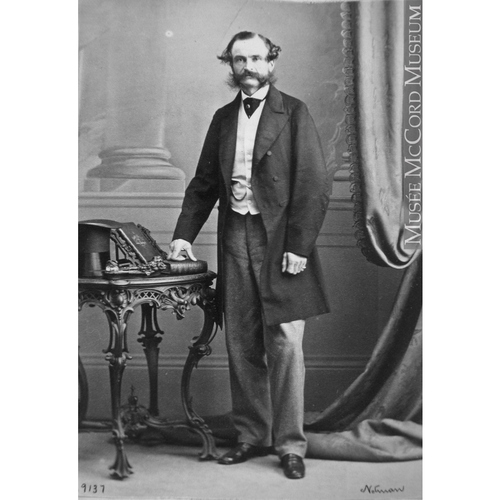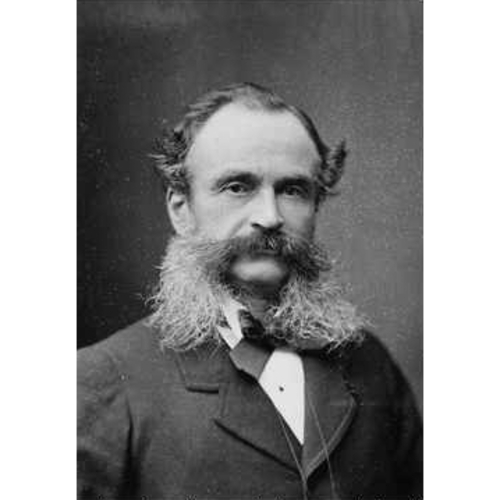
Source: Courtesy of Wikimedia Commons
JERVOIS, Sir WILLIAM FRANCIS DRUMMOND, army officer and military engineer; b. 10 Sept. 1821 in Cowes, Isle of Wight, England, son of William Jervois (Jervoise) and Elizabeth Maitland; m. 19 March 1850 Lucy Norsworthy in Paddington (London), and they had three sons (one did not survive childhood) and three daughters; d. 17 Aug. 1897 in Woolston (Southampton) and was buried at Virginia Water.
William Francis Drummond Jervois (pronounced Jer-vus) came from a military family of Huguenot descent. Educated at Dr Burney’s Academy, Gosport, and the Royal Military Academy, Woolwich (London), he was commissioned second lieutenant in the Royal Engineers in 1839. He attended the Royal Engineers Establishment at Chatham for two years and took up his first posting, at the Cape of Good Hope, in August 1841. In South Africa he initiated surveys of British Kaffraria, helped construct military defences, and took up a lifelong avocation as a water-colourist of some distinction. Returning to Britain in 1848, he became the commanding royal engineer for the London District in 1855 and deputy inspector-general of fortifications the following year. By this time he had contributed several significant technical reports on the modernization of London’s defences.
In September 1863, during the American Civil War, Sir John Fox Burgoyne, inspector-general of imperial fortifications, sent Jervois, then a lieutenant-colonel, to Bermuda and Canada to report on fortifications there. Jervois visited the United States twice that year, setting out into the harbours of Portland and Boston in a row-boat, disguised as an artist, to make sketches of their defences. He concluded that war on colonial soil, between Britain and the Northern armies, was quite likely, and in his report, formally submitted in February 1864 (its general contents were known earlier), he recommended that Halifax, Quebec, and Montreal be fortified further and that British regulars be concentrated at the last two cities. He did not believe that the Great Lakes could be held and concluded that defence west of Montreal was impossible.
Soon after submitting his report, Jervois became caught in the cross-fire of colonial-imperial politics. Although the imperial government was willing to finance improvements at Quebec, London hoped to persuade the Province of Canada to undertake the works at Montreal. Jervois was sent back to North America in the summer of 1864 to so advise the Canadian government. The Canadian ministers met with him in October, at the time of the Quebec conference on confederation, and the following month received another, more optimistic report, in which he also included New Brunswick and Bermuda. Calculated to win Canadian support, it argued that temporary fortifications westwards to Hamilton, and a naval force on Lake Ontario supported from Kingston, would make strategic withdrawal possible. The coming of snow – he hoped for a stalemate through the intervention, he wrote, of “General Winter” – and the dominance of Britain’s Atlantic fleet would make victory over the Americans attainable.
Unhappily for both the Canadian co-premier, John A. Macdonald, and Jervois, his report was prematurely released in London. Macdonald, fearing panic in Upper Canada, was angry. Others in the province felt, correctly, that Jervois had not addressed the question of Canada’s future or of Britain’s commitment, were there to be a successful American invasion. Though Jervois’s report, which leaned heavily on the assumption of British naval superiority, was well received in Britain, land-locked Canadians felt abandoned. Recalled to London in 1865, Jervois was convinced that his reports had not been dealt with in Canada on their technical merits and that Macdonald had forced his removal. Despite a British vote of £50,000 in early 1865 for the defences of Quebec, his first report was not fully acted upon by the Canadian government, in part because of public pressure to keep British troops in Upper Canada [see Sir Casimir Stanislaus Gzowski]. The Canadian and British governments did agree, however, to implement the broad outlines of his second report. In 1868 the dominion government authorized a loan to erect fortifications but they were not built, and in 1871 the British guarantee for the loan was applied instead to the construction of the Intercolonial Railway.
From 1865 to 1874 Jervois lectured on iron fortifications and travelled widely to inspect imperial defences, especially in India, the Mediterranean, and Bermuda. Knighted in 1874, he accepted the governorship of the Straits Settlements the following year. There his actions drew Britain more deeply into the archipelago. His inability to work effectively with Malay leaders and rebellious groups intensified a local uprising to the extent that he had to call for reinforcements from India and Hong Kong. More than any other governor, he was responsible for the decisions that ultimately led to Britain’s acquisition of what became Malaya. This was at a time when the Colonial Office consistently cautioned against expansion, and in 1877 Jervois was withdrawn from Singapore and asked to survey the defences of Australia and New Zealand. He was succeeded as governor by Sir William Cleaver Francis Robinson.
While in Melbourne, Jervois was informed that he had been appointed governor of South Australia. He arrived at Adelaide in October 1877 to find the colony in a political crisis; when the ministry resigned, Jervois won local praise for his careful handling of the situation. During the subsequent period of economic growth and excellent rainfall, he became an effective and popular governor. He continued his reports on coastal fortifications, oversaw the construction of new houses of parliament, and enjoyed introducing Turkish bathing and horse-racing to the South Australian public.
In 1882 Jervois was appointed governor of New Zealand, and he remained there until 1889. He disliked the colony but, except for a clash with political leader Sir Julius Vogel in 1884, he was a well-liked and courageous governor. He came to respect Maori culture and advocated equal treatment for Chinese immigrants. During the Anglo-Russian crisis of 1885 over Afghanistan, a Russian gunboat put into Wellington harbour and Jervois was asked what he was going to do. “Do?” he replied. “Why invite them to tea,” which he did.
In 1893, in retirement, he became colonel-commandant of the Royal Engineers. In his final years he published several papers and spoke frequently on Malay matters at the Royal Colonial Institute. By the time of his death, in a carriage accident in 1897, he had acquired most of the merit badges that life afforded colonial governors in the Victorian period: cb in 1863, kcmg in 1874, and gcmg in 1888.
Jervois’s Canadian reports were issued by G. B., War Office, as Report on the defence of Canada, and of the British naval stations in the Atlantic, by Lieut.-Colonel Jervois; part I: defence of Canada (London, 1864; copy at NA) and Report on the defence of Canada, made to the provincial government on the 10th November 1864, and of the British naval stations in the north Atlantic; together with observations on the defence of New Brunswick . . . (London, 1865).
GRO (London), Death certificate, W. F. D. Jervois, 19 Aug. 1897; Reg. of marriages in the registration district of Kensington, Paddington, and Fulham ([London]), no.115 (19 March 1850). Isle of Wight County and Diocesan Record Office (Newport, Eng.), St Mary’s Church (Cowes), reg. of baptisms, 16 Oct. 1821. Private arch., R. W. Winks (New Haven, Conn.), Jervois papers. RHL, Jervois papers. Corps Archaeological (Chatham, Eng.), 2 (1898). ADB. DNB. Brian Jenkins, Britain & the war for the union (2v., Montreal, 1974–80), 2. R. A. Preston, The defence of the undefended border: planning for war in North America, 1867–1939 (Montreal, 1977). R. W. Winks, Canada and the United States: the Civil War years (Baltimore, Md., 1960).
Cite This Article
Robin W. Winks, “JERVOIS, Sir WILLIAM FRANCIS DRUMMOND,” in Dictionary of Canadian Biography, vol. 12, University of Toronto/Université Laval, 2003–, accessed January 1, 2026, https://www.biographi.ca/en/bio/jervois_william_francis_drummond_12E.html.
The citation above shows the format for footnotes and endnotes according to the Chicago manual of style (16th edition). Information to be used in other citation formats:
| Permalink: | https://www.biographi.ca/en/bio/jervois_william_francis_drummond_12E.html |
| Author of Article: | Robin W. Winks |
| Title of Article: | JERVOIS, Sir WILLIAM FRANCIS DRUMMOND |
| Publication Name: | Dictionary of Canadian Biography, vol. 12 |
| Publisher: | University of Toronto/Université Laval |
| Year of publication: | 1990 |
| Year of revision: | 1990 |
| Access Date: | January 1, 2026 |





